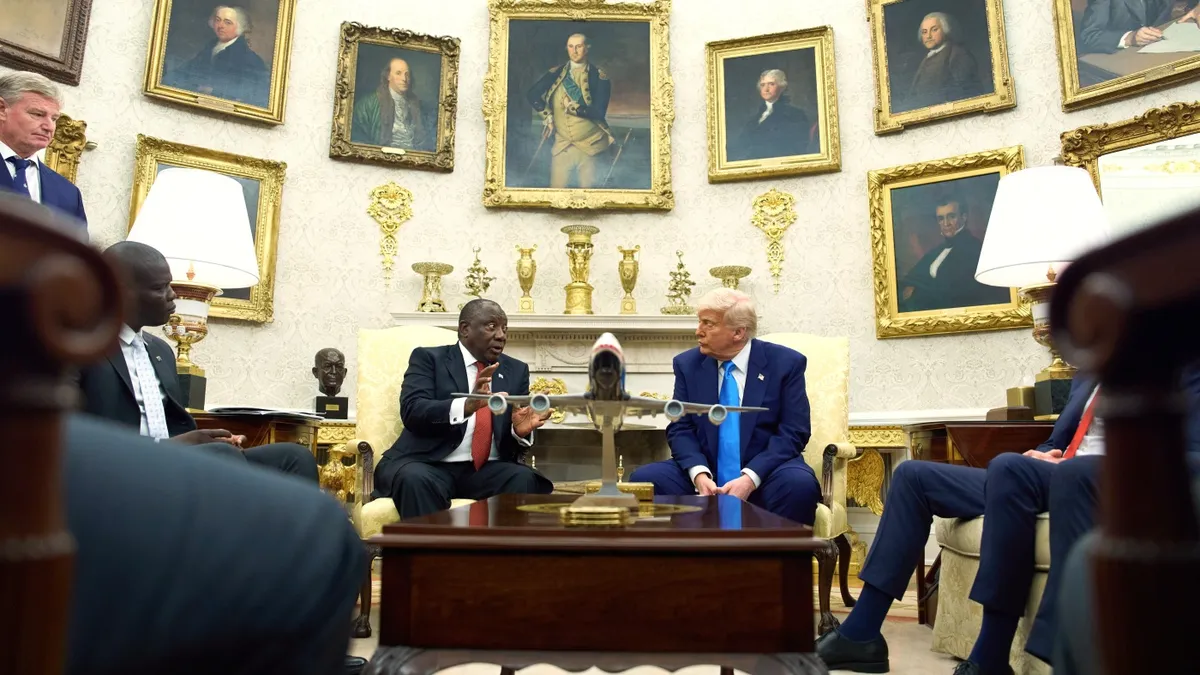
In an extraordinary meeting held in the Oval Office on Wednesday, South African President Cyril Ramaphosa faced a mix of challenges and unexpected moments with U.S. President Donald Trump. One South African newspaper described the encounter as "awful but it could have been worse," reflecting the tension that surrounded the meeting. Many South Africans, including members of the government delegation, were apprehensive about a possible repeat of February's contentious dialogue between Trump and Ukraine's President Volodymyr Zelenskyy.
During the meeting, Trump engaged in what some media outlets referred to as "serious provocation." Notably, he requested the lights be dimmed to showcase a lengthy montage of video footage that purported to illustrate the concept of white genocide in South Africa. Despite these controversial tactics, Ramaphosa maintained his composure, showcasing his experience as a seasoned negotiator and former protégé of Nelson Mandela. He played a pivotal role in the negotiations that dismantled apartheid in 1994, a testament to his diplomatic skills.
Following the meeting, many South African media outlets and social media users commended Ramaphosa for his calm demeanor, even amidst what was widely characterized as an ambush by Trump. Some, however, expressed a desire for him to respond more assertively. In the Daily Maverick, writer Rebecca Davis poignantly questioned, "Who among us did not also secretly yearn to see Ramaphosa fight back a little more?"
In a press briefing later that day, Ramaphosa attempted to frame the meeting in a positive light. He revealed that discussions during the subsequent lunch went smoothly, hinting at the possibility of Trump attending the upcoming G20 summit in Johannesburg later this year. Ramaphosa addressed the anxiety felt by many South Africans, referencing concerns of a "Z moment," presumably alluding to the earlier tense exchange with Zelenskyy. He humorously noted his disappointment in not providing the dramatic encounter that some members of the press were hoping for, prompting a lighthearted remark from a reporter about the day's events being quite dramatic.
Despite the South African delegation's efforts to clarify the situation, Trump continued to propagate a right-wing conspiracy theory alleging systematic persecution and genocide of white South Africans. He misrepresented a protest video intending to commemorate victims of violent crime, falsely framing it as an indication of widespread violence against white farmers. News24, a South African news outlet, debunked Trump's claims, clarifying that the number of crosses depicted in the video did not correlate with actual murder statistics.
Trump's meeting included the presence of prominent South African figures, including renowned golfers Ernie Els and Retief Goosen, as well as business tycoon Johann Rupert. The inclusion of these white South African businessmen was intended to ease tensions; however, it sparked criticism from various quarters. Ramaphosa's team believed that their presence would help navigate the meeting's complexity. Els, a personal friend of Trump, seemingly supported Trump's narrative, causing discontent among many who viewed it as a perpetuation of apartheid-era sentiments.
In his defense, Ramaphosa acknowledged the golfers as patriots but admitted they could have been better prepared for such a high-stakes meeting. The treatment of Ramaphosa by Trump raised eyebrows, with numerous South African media outlets pointing out the disparity in respect shown to authoritarian leaders compared to a democratically elected head of state.
Overall, the encounter between Ramaphosa and Trump serves as a complex case study of diplomacy, media representation, and the intricate dynamics of international relations, particularly regarding race relations in South Africa.